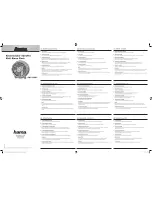
NEVER use an open flame of any kind to test this smoke alarm. You might accidentally damage
or set fire to the smoke alarm or to your home. The built-in test switch accurately tests the
smoke alarm's operation as required by Underwriters Laboratories Inc. (UL).
(UTHA) Sensitivity Indicating Means
The sensitivity indicating means for this Smoke and Fire Alarm is the use of the analyzer for Smoke
Detectors Model 501-A or 501-A/Bat Aerosol Generator Manufactured by Gemini Scientific Corp.,
1122-B Aster Ave., Sunnyvale, CA 94086.
The Equivalent UL 268 Light obscuration %/Ft as measured by this instrument must be within the
obscuration listed on the back of this alarm.
(UTHA) Go/No-Go Field Test
The Go/No-Go test for this smoke and fire alarm is to use one of the following UL listed can-type aerosol
smoke alarm testers. The instructions for use are printed on the canister. Home Safeguard, Model 25S.
If you choose to use an aerosol smoke product to test the smoke alarm, be certain to use one
that has been Listed to Underwriters Laboratories, Inc. Safety Standards and use it only as
directed. Use of non-UL Listed products or improper use of UL Listed products may affect
the smoke alarm's sensitivity.
(UTHA) MAINTENANCE:
The alarm is virtually maintenance free. However, under dusty conditions, a vacuum hose may be
used to clear the sensing chamber of dust.
Clean the alarm at least once a month
to remove dust, dirt, insects or debris. Always turn off power to
alarm before cleaning. Using a soft brush or wand attachment to a vacuum cleaner, vacuum all sides and
cover of the alarm. Be sure all the vents are free of debris.
If the alarm is false alarming and cannot be restored to normal operation, the alarm should be replaced.
WEEKLY TESTING
This alarm is designed to act as a monitor, not for use as a short-term testing device, to
perform a quick check for the presence of CO or gas. WARNING: Natural gas (methane) is
highly explosive. An attempt to test the unit by exposing it to natural gas outside of a controlled
labatory environment can produce an explosion and death. NEVER use a gas range or an
open flame of any kind to test this alarm. You might accidentally damage or set fire to the
alarm or to your home. NEVER use vehicle exhaust to test the alarm! Exhaust may cause
permanent damage and voids your warranty. The built-in test switch accurately tests the
alarm operation as required by ANSI/UL2034 Standard for Safety. If, at any time, you test the
alarm and it does not perform as described, replace it immediately.
It is important to test this alarm every week to make sure it is working properly.
USING THE TEST FEATURE:
Press and release the TEST button on the alarm cover.
During testing, you will hear: 3 beeps (red LED on), 2 second pause, 3 beeps (red LED on), 6
second pause, 4 beeps (red LED on), 5 second pause, 1 beep (blue LED on).
If the alarm does not sound properly:
1. Make sure the AC power is applied and the battery is fresh and installed correctly.
2. Test the alarm again.
Page 12
END-OF-SERVICE LIFE NOTIFICATION:
A majority of home fire deaths are a result of no smoke alarms
or no
working
smoke alarms. In addition to the "replace by date" stamped on the back of your alarm, your
alarm contains a unique audible end-of-service life notification feature. When it is time to replace your alarm,
which is after approx. 7 years of operation from initial power up, the alarm will sound 2 chirps approx. every
20 seconds. The green LED stays on. The alarm should be replaced immediately.The product end-of-
service life notification can be temporarily silenced for a 10 hour period for up to 20 days. After 20 days, the
warning cannot be silenced. The alarm should be replaced immediately.




































